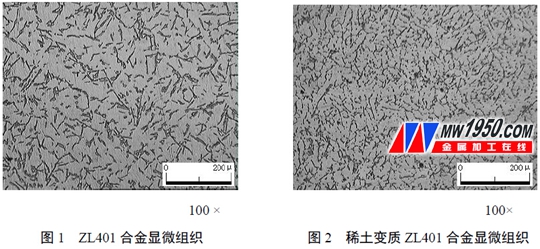The ZL401 alloy is generally referred to as a Zn-containing aluminum-silicon alloy, and its composition is w Zn = 9.0% to 13.0%, w Si = 5.0% to 8.0%, w Mg = 0.1% to 0.3%, and the balance is Al. Since zinc is completely dissolved in α(Al), the as-cast structure is the same as ZL101, and is composed of α(Al)+eutectic α(Al)+Si. Such alloys have medium casting properties, small shrinkage cavities and thermal tendency, good weldability and cutting performance, high strength in the as-cast state, low plasticity, high density and poor corrosion resistance. Mainly used as plastic molds, stencils, brackets for certain equipment, and automotive and aircraft parts with a working temperature not exceeding 200 °C. Since this alloy has a high silicon content, it needs to be subjected to deterioration treatment. After the metamorphism treatment, the eutectic silicon structure in the alloy is refined to improve the mechanical properties. At present, the research on metamorphic treatment in aluminum-silicon alloy is extensive, and the research on the influence of aluminum-zinc alloy is rarely reported. The research in this area is still in its infancy.
In this paper, the effect of Al-12%Zn-7%Si-0.2%Mg on the microstructure and Brinell hardness of the alloy was studied by adding mixed rare earth containing 30% niobium and 70% niobium.
Test material
The main materials tested were ZL102 (w Si = 10.0% to 13.0%, the balance being aluminum), pure zinc, pure aluminum, and pure magnesium. The refining agent is hexachloroethane, and the modifier is a mixed rare earth of 30% La+70% Ce.
2. Preparation of ZL401 alloy pattern
The general order of addition is to add low-melting zinc and Al-Si alloy ingots, and then add aluminum ingots with higher melting point. After all the melting, add magnesium ingots, stir them evenly, then they can be refined, deteriorated and allowed to stand. After 15 to 20 minutes, the slag is slag, and the temperature is raised to 700 ° C and then poured. The test was carried out in two groups, one with no deteriorating agent and the other with 1% cerium mixed rare earth. Cut the middle part of the two sets of ingots, the specifications are 15mm × 15mm × 20mm, after smoothing and polishing, etched with 0.5% hydrofluoric acid for about 5s, washed with anhydrous ethanol, and then dried by blowing. The microstructure was observed under a phase microscope and the Brinell hardness was measured.
3. Effect of lanthanum mixed rare earth on microstructure of ZL401 alloy
In general, the phase composition of the as-cast ZL401 alloy is: α, Si, and Mg 2 Si, and when Fe impurities are present, β (Al 9 Fe 2 Si 2 ) or the like is formed. Figure 1 shows the microstructure of ZL401 alloy in as-cast condition, in which the Si phase is gray needle-like, the Mg 2 Si phase is black skeleton, and the white is α solid solution; Figure 2 shows the transformation of the lanthanum mixed rare earth. The microstructure of the ZL401 alloy, the eutectic Si is in the form of fine particles, and the distribution in the matrix is ​​more uniform.
The metamorphism mechanism of rare earths is complicated. Some research data show that the addition of rare earths weakens the bonding between Si-Si and Si-Al radicals and strengthens the bonding of Al-Al radicals, resulting in the first phase nucleation of the α phase and the Si phase. In the case of cold, eutectic crystallization, the α phase precipitates and grows as the leading phase, thereby limiting the growth of the eutectic silicon. There is also a view that Ce has a very low solid solubility in aluminum alloys, and a large component tends to be too cold. When dendrites grow, Ce is discharged to the side, hindering side growth, and when the protruding portion of the dendrite breaks through the rich Ce layer. When the ingredients are too cold and grow dendritic branches, a "neck" occurs at the branches. Since the "necked" portion has a large curvature and a low melting point, it is easily melted and detached and is entangled in the liquid flow. Since the temperature inside the liquid fluctuates, the dendrite is proliferated and expanded, thereby refining the crystal grains.

4. Effect of lanthanum mixed rare earth on Brinell hardness of ZL401 alloy
The hardness test was carried out on a HB3000 Brinell hardness tester with a test load of 2500 N, a dwell time of 30 s, and a head diameter of 5 mm. After unloading, the indentation diameter was read through a reading microscope, and the Brinell hardness HBW value was calculated as shown in the attached table.
Brinell hardness test results for different treatment styles

It can be seen from the attached table that the Brinell hardness of the alloy is increased by 5.5% after the metamorphism of the mixed rare earth. This is because the eutectic silicon is refined to some extent after the rare earth metamorphism. At the same time, the grain refines from the dendrites to the equiaxed crystals, the dendrites gradually disappear, the grains are more rounded, and the distribution is more uniform. As the grain size becomes smaller and smaller, the hardness of the alloy becomes higher and higher.
5 Conclusion
(1) Under a certain amount of cerium mixed rare earth metamorphism, the solidification structure of ZL401 alloy is refined, and the elongated eutectic silicon becomes granular or short rod.
(2) After the rare earth modification treatment, the crystal grains are refined, and the Brinell hardness of the alloy is improved to some extent.
Antimony Ingot
Antimony Ingot,Antimony Lead Ingots,Antimony Metal Ingots,Bismuth Metal Ingot
HUNAN ZHONGNAN ANTIMONY&TUNGSTEN TRADING CO.,LTD , https://www.znat.com.cn